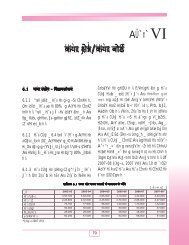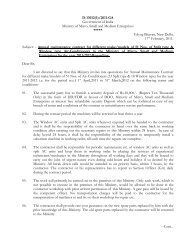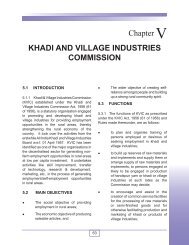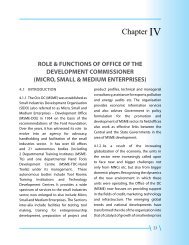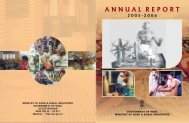Evaluation Study MSE Cluster Development - Ministry of Micro ...
Evaluation Study MSE Cluster Development - Ministry of Micro ...
Evaluation Study MSE Cluster Development - Ministry of Micro ...
Create successful ePaper yourself
Turn your PDF publications into a flip-book with our unique Google optimized e-Paper software.
Chapter No: 3 – The <strong>Cluster</strong> <strong>Development</strong> Executive/Agentcluster development. It should be noted that the number <strong>of</strong> CDEs responding on theseissue is fairly low. To some extent this reflects a lack <strong>of</strong> awareness regarding the CDPitself. The identification and ranking <strong>of</strong> factors enabling cluster development depends onhow comprehensively the CDE understands and perceives the various issues involved.Table No.-3.6: RESPONSES OF CDES ON PRIME FACTORS ENABLING CLUSTERDEVELOPMENTSl. PRIME FACTORS NUMBER OFCDESRESPONDINGRANKINGOF PRIMEFACTORS1. <strong>Cluster</strong>s that are less dispersed 13 42. High Skill based <strong>Cluster</strong>s 4 123. High Product range clusters 7 104. <strong>Cluster</strong>s with greater access to R&D institutions 12 55. Labour intensive clusters 5 116. High Density <strong>Cluster</strong>s 8 97. Highly Homogeneous <strong>Cluster</strong>s 14 38. <strong>Cluster</strong>s facing threats from competitors 9 89. <strong>Cluster</strong> with well established and active16 1associations10. <strong>Cluster</strong>s with common facilities (for testing,10 7quality control, and standardization)11. <strong>Cluster</strong>s with clarity <strong>of</strong> Vision and Mission 15 212. <strong>Cluster</strong>s with greater access to Information 11 613. <strong>Cluster</strong>s endowed with an abundance <strong>of</strong> locallyavailable raw materials.11 6It is seen that the largest number <strong>of</strong> responses pertains to seven <strong>of</strong> the 13 prime factorslisted in the table namely:• <strong>Cluster</strong>s with well-established and active associations.• <strong>Cluster</strong>s with clarity <strong>of</strong> Vision and Mission.• Highly homogeneous clusters.• <strong>Cluster</strong>s that are less dispersed.• <strong>Cluster</strong>s with greater access to Research and <strong>Development</strong>.• <strong>Cluster</strong>s with greater access to information.• <strong>Cluster</strong>s endowed with an abundance <strong>of</strong> locally available raw materials.It is seen that these seven factors are also ranked highly. The remaining factors areperceived to be relatively less important and ranked accordingly. However this does notmean that they should not be considered, in the identification <strong>of</strong> potentially viable andsustainable clusters.It also needs to be mentioned that the seven prime factors are fairly quantifiable and ifcorrectly measured or assessed at the diagnostic or even pre-diagnostic stage preferablyby a competent agency or an expert appointed to carry out such pre-diagnostic studies,they may further be developed into a viability and sustainability index which shouldenable the choice and prioritization <strong>of</strong> intervention.75





